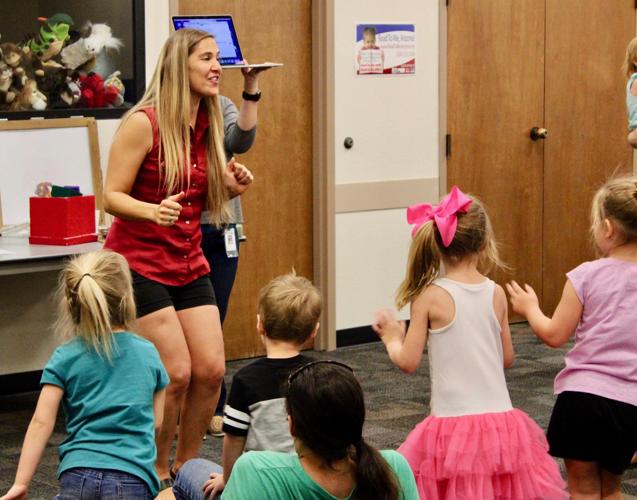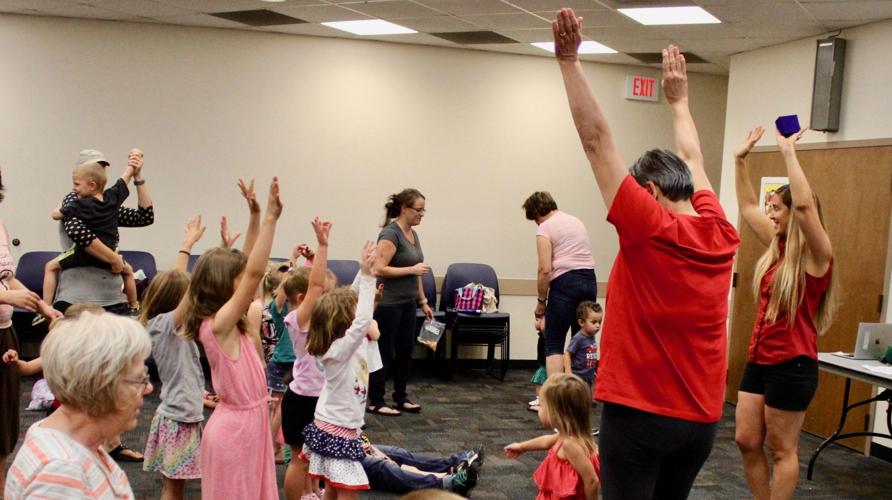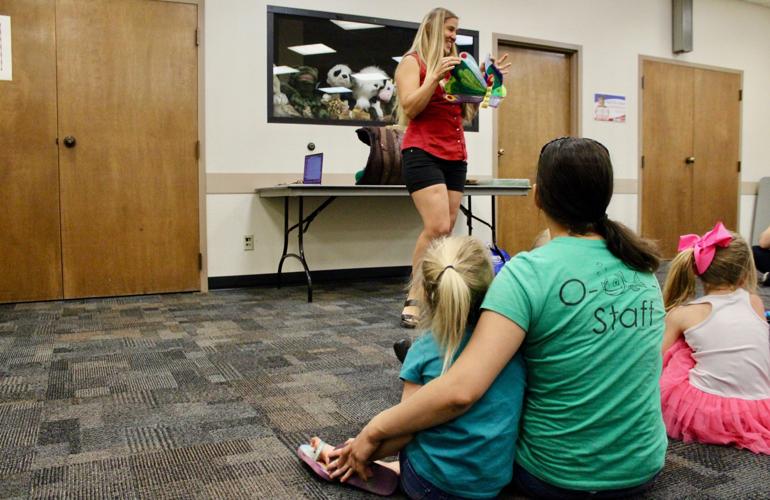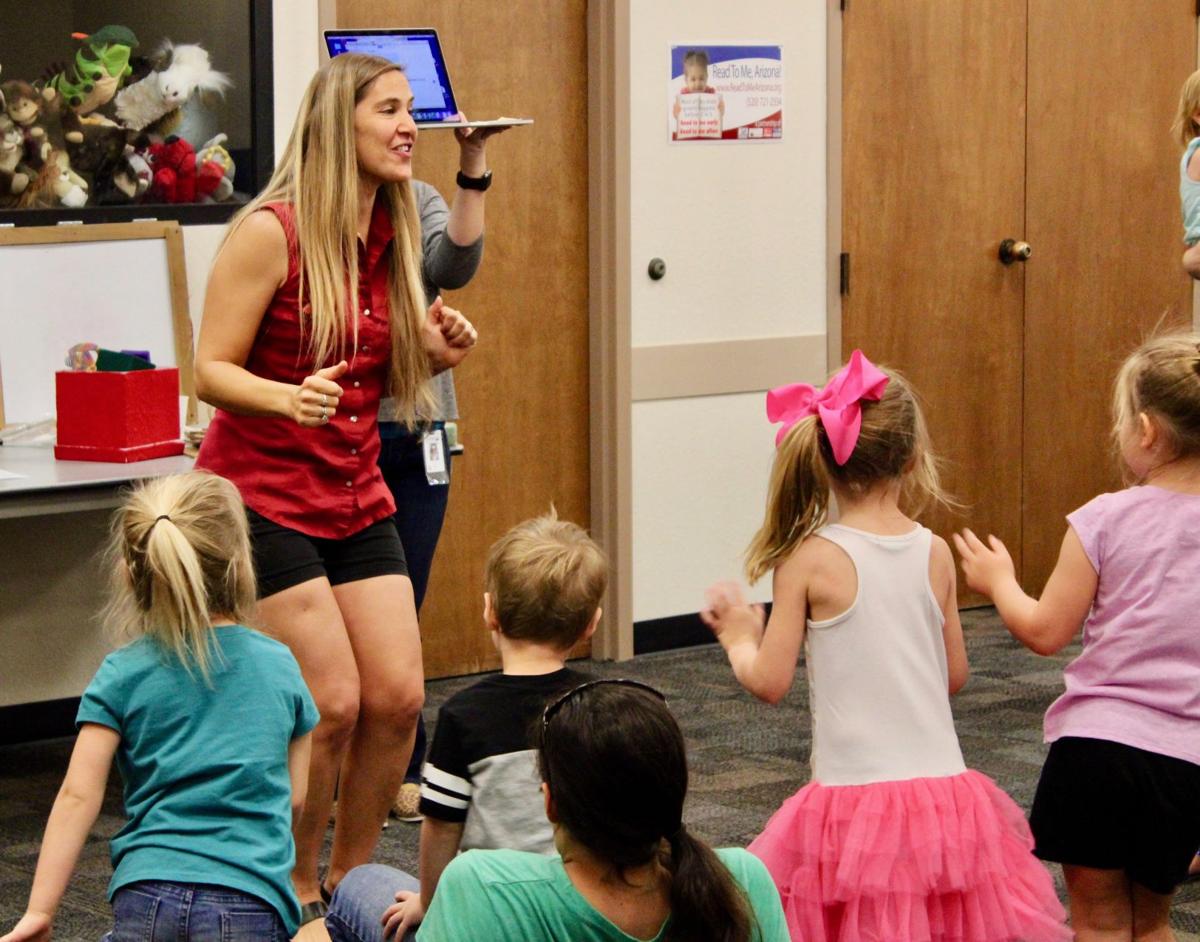As Libby Quinn finishes up a story time for toddlers, dozens of little hands fly into the air, fluttering back and forth.
They're applauding — using American Sign Language.
Quinn works in schools, preschools and libraries to teach young kids to communicate with sign language. Quinn, the owner of Little Talking Hands Tucson, isn't deaf, but learning the language comes naturally to her.

Libby Quinn incorporates sign language into her story times to enhance communication and understanding.
That's thanks to a friend who she met while working at a restaurant in Texas. On slow days, Quinn would dawdle near the storefront with the hostess, a deaf woman who taught Quinn the signs for words she could already fingerspell with the American Sign Language alphabet.
"I really fell in love with the language," Quinn says.
She moved to Tucson about 15 years ago and didn't want her newfound passion to fade. She got a job with the Community Outreach Program for the Deaf and then ended up working as an aide at the Arizona State Schools for the Deaf and Blind.
She left that job about 18 months later after the birth of her daughter. Even while pregnant, she knew she wanted to teach her baby to sign.
In Quinn's experience, teaching her daughters — now 8 and 13 — to sign strengthened her bond with the girls by enabling communication even before they could speak.
"When you get your kids to show you with their hands, it helps the communication gap so there's less frustration, and when there's less frustration, there's a closer bond," she says.
Even when kids do begin to speak, Quinn says knowing signs can supplement communication. She gives the example of a child at the zoo who can't yet say the word "rhinoceros" but can sign it.
While staying home with her daughters, Quinn began to teach other parents to baby sign — the origins of Sign with Baby Tucson, the business that evolved into Little Talking Hands.
As her girls entered school, she began teaching sign language more widely — at Temple Emanu-El's early childhood program, Child-Parent Centers and Community Extension Programs.
Although she no longer works with Community Extension Programs, she has added Canyon del Oro High School's preschool and Pima County Public Libraries to her teaching repertoire. She says she teaches about twice a month at each of her schools.

Libby Quinn finishes up her telling of "The Very Hungry Caterpillar." Quinn taught and encouraged children to use signs for colors throughout the story.
Kurtis and Dawn Durfey began to learn baby signing from Quinn before their 4-year-old daughter Eloise was born.
"I would definitely recommend it to anyone, and Libby was awesome," Dawn says. "She made it really comfortable and user-friendly."
Teaching Eloise to sign eased communication frustrations early on, especially since she was a late speaker.
"I remember watching her do 'all done.'" Dawn says. "She is waving her hands like crazy. It was like, 'Okay, you don't want any more.' Instead of crying, she was telling us."
Kurtis adds: "I think it enriches the relationship a lot."
"She didn't have to resort to flipping out before we finally realized what she was trying to tell us," Dawn continues.
The couple (who now live in Oregon), believe that foundation of communication has stuck with them even now that Eloise speaks verbally and their own sign language vocabulary has dissipated a bit.
Quinn says she still signs with both daughters when a moment arises. She remembers taking her own daughter to a story time years ago. The little girl stood front and center before a crowd. Instead of shouting, Quinn signed, "Sit down." Her daughter sat and no one was embarrassed.
She remembers a gymnastics meet, where she was able to sign "I love you" to her daughter from across the room.
Quinn herself never went to school for this — she studied music education and then music business in college. She learned American Sign Language from her hostess friend in Texas and through ASL immersion programs that prohibit verbal communication. Quinn says she has been to approximately 15 and is now fluent.
"I don't teach kids just a language, I teach them a way to communicate," she says. "That's what I always focus on."
It's Wednesday morning when Quinn stands before a group of more than 70 for a toddler story time at the Nanini Library. Using a rhyme, she teaches the audience the signs for colors and then leads them through stories such as "The Very Hungry Caterpillar" and "Mouse Paint" using those signs.

Libby Quinn reads "Mouse Paint" to toddlers and preschoolers at the Nanini Library during a story time.
Cat Strong, the children's librarian at Nanini, says that Quinn brought her own children to story times at this library years ago.
"Signing helps with language development," Strong says. "It gives them context behind the words. We are trying to help prepare children for school."
Quinn primarily works with young children. These are the years when it really matters, she says.
"I really like preschool, because you can see how much they learn because it's really the start of everything," she says. "I just think when you're raising your kids in the beginning, that's the foundation."








